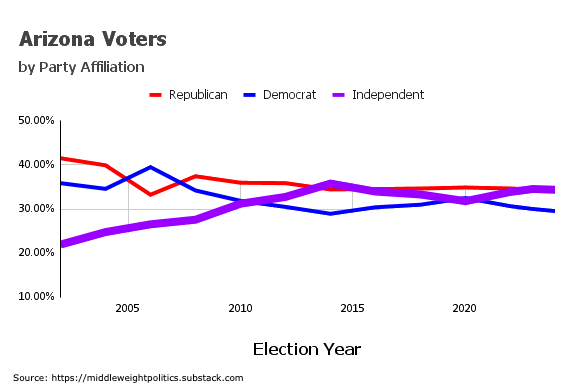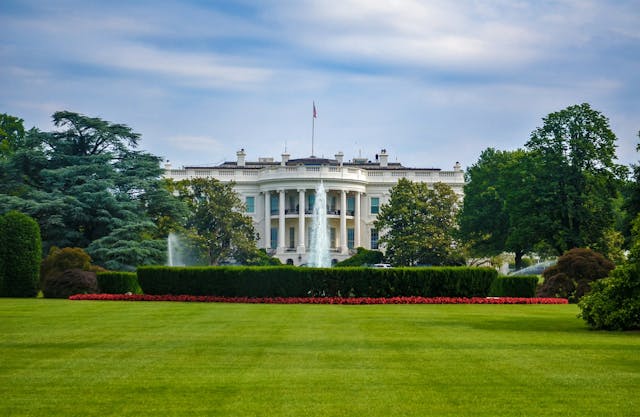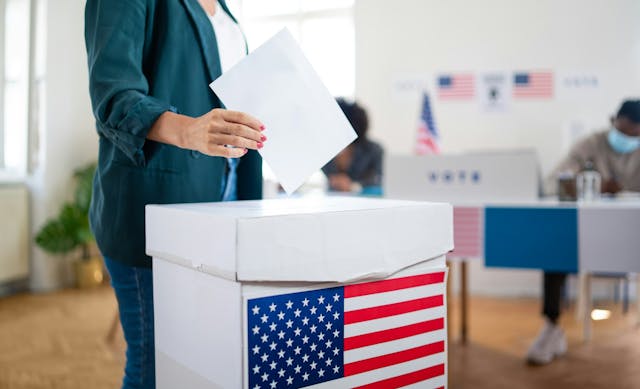Sinema's Exit Could Be Bad News for Democrats -- Here's Why

Editor's Note: This article originally appeared on Dan Sally's website and has been republished on IVN with permission from the author. Photo Credit: Gage Skidmore / Flickr
To many, the 2024 presidential primary has been like the movie Titanic - overly long and ending in a disaster we all saw coming from the start. After months of campaigning and five televised primary debates, Americans are now faced with a rematch between two candidates polling shows a majority of them didn’t want.
While news of Biden and Trump’s chief rivals suspending their campaign dominated the headlines, they crowded out news of another candidate dropping out that could have a greater impact on the 2024 election cycle. That of Arizona Senator, Kyrsten Sinema.
Sinema was reliable for being one of the few members of the Senate who tried to bridge the growing gap between Republicans and Democrats by helping negotiate legislation on infrastructure and immigration reform. As a Democrat, she was also reliable for irritating her fellow party members by voting against them on issues such as filibuster reform and Biden’s Build Back Better plan.
As rumors began to swirl about a potential Democratic primary challenge, Sinema left the party to enroll as an independent - raising concerns she might act as a spoiler in a three-way race in 2024.
So many on the Democratic were relieved when she announced she wouldn’t seek reelection.
But should they be? After digging into the data, probably not.
Arizona: Turning Blue, or Just Less Red?
Arizona had long been a conservative stronghold until Donald Trump came along and ruined it by questioning whether John McCain’s time in a tiger cage in Vietnam qualified him for the title of “war hero” - one of his numerous unforced errors during the 2016 campaign.
Whether or not this was what turned Arizona against him is unclear - but he ended up being the first Republican not to receive the support of a majority of voters in the state since 1996.
This could be passed off as a fluke, as Libertarian Gary Johnson took a little over 4% of the vote and Trump did win the state, were it not for the fact he ended up losing Arizona outright in 2020 - breaking another 20-year Republican winning streak.
In addition to losing the state for himself, he also appears to have lost it for everyone else in his party, with Republican Martha McSally losing to then-Democrat Kyrsten Sinema for the seat left vacant by Jeff Flake (who - coincidentally - Trump had more or less forced out).
Regardless, McSally ended up being sworn in alongside Sinema in January of 2019 after being appointed by the state’s Republican governor to fill the seat left vacant by retiring senator, John Kyl. She enjoyed a 2-year run in the Senate until she was defeated again - this time by Democrat Mark Kelly in 2020.
Trump’s campaign-killing spree continued in 2022 when two candidates he endorsed - Blake Masters for Senate and Kari Lake for governor - lost to their Democratic rivals.
This string of losses has led many to speculate that this once reliably red state is turning blue, but the reality is it’s just turning less red.

Data from Arizona’s Secretary of State shows that Republicans have seen a steady decline in voter registration over the last 20 years - falling from 41% of registered voters in 2002 to a little under 35% as of January of this year.
This would be great news for Democrats - if they weren’t sinking as well.
Over the same period, they’ve shrunk from a little under 36% of all registered voters to under 30%.
This trend reversed briefly in 2020 when Democrats saw a bump in their numbers and came close to even with Republicans, but that trend has since reversed.
Over that same period, independents have grown from just under 22% of the vote in 2002 to over 34% in January of this year - putting them neck and neck with Republicans for the state’s largest voting bloc.
This is in line with the national trend over the last 20 years, which has seen both parties lose ground to independents, albeit Republicans have a bit more strength in Arizona than they do nationally.
So - with more voters leaving the two major parties to register as independents, how have the Democrats and Republicans of Arizona responded?
They haven’t.
Choose Any Color, As Long As It’s Red or Blue
With both parties losing approximately 15% of their voters over the last 20 years, you’d expect that they’d change tactics to woo independents back into the tent, but both parties appear to be doubling down on their old playbook.
Arizona Republicans appear ready to nominate Kari Lake, who supports the idea that the 2020 election was stolen, was still challenging her own 2022 election loss in court last fall, and recently attended a fundraising event sponsored by high-profile QAnon Supporters.
This gives her Democratic opponent, Ruben Gallego, the advantage in that he appears to be running on the same planet as his voters. That being said, Gallego has a fairly liberal voting record in the House when compared to Democrats who’ve won statewide office and with Arizona’s congressional delegation on the whole.
As it stands, Gallego’s voting record puts him among the top 20% most liberal House members and the top 40% most liberal Democrats. In contrast, his Senate counterparts, Mark Kelly and Kyrsten Sinema, are among the top 20% most conservative Democrats.
While serving in the House, Sinema was more conservative than all but 3% of Democrats.
So there’s proof Democrats can win statewide elections in Arizona, but it’s unclear how far to the left voters are willing to go. And while voters in the state have eschewed MAGA candidates to date, Lake only lost her 2022 gubernatorial bid by a margin of under 1% - around 17,000 votes.
In this sense, Democrats in the state may have opted for the greater of two evils by pushing for a challenger to Sinema, with one Democratic adviser recently wondering aloud if they’d handed the election to Lake.
A Choice Other Than Poison
It’s fair to ask that, if Sinema truly is the best candidate, why wouldn’t she opt to run for reelection? The answer lies more in the mechanics of elections in the United States than in whether voters want her to serve another term.
Most elections in the US rely on a system known as first-past-the-post, where the candidate with the most votes wins. This sounds logical, until you realize “the most votes” in a three-way race could be as little as 33% +1 vote.
Systems like this encourage voters to vote strategically rather than simply casting ballots for the candidate that best aligns with their views, as voting for the person you like the most could tilt the election in favor of the one you like the least. In the case of Arizona, voters who might prefer Sinema would have to weigh the likelihood that their vote could tilt the election in favor of Lake before casting their ballot.
Another fair question is why Sinema didn’t simply run as a Democrat.
This would require Sinema to win the state’s Democratic primary - an election to determine which candidate is most popular amongst Democrats. Given her positions in the Senate ultimately resulted in her leaving the party, Gallego would have a clear advantage.
So, while Arizona’s voters - like Sinema - have moved away from America’s two major parties, this only seems to mean a smaller number of Arizonans decide which candidates make it on the ballot.
Better Ballot Arizona is pushing to change Arizona’s system of elections to one known as Final Five Voting, which they say would reduce the outsized sway the two major parties have over which candidates make it on the ballot and make it easier for independent and minor party candidates to have a voice in elections. Final Five differs from the current system in two ways.
The first is that it replaces party primaries with an open primary where all candidates from all parties compete for all voters, and the top five vote-getters appear on the ballot in the general election. This requires candidates to appeal to a broader cross-section of voters, as opposed to the current system that encourages candidates to campaign to their party’s base.
Second, it would replace the current first-past-the-post system of elections with ranked-choice voting, where voters rank their candidates in order of preference instead of choosing just one. This eliminates the problem of an independent candidate splitting the vote, as voters can throw their support behind another candidate if their first choice doesn’t win.
While Arizona has earned the moniker of “battleground state” in recent years, the battle seems to be over which party is losing support the slowest, as opposed to which is gaining ground. This is due to an out-of-date system that gives the two major parties outsized sway over who makes it on the ballot, and crowds out alternative candidates that might have broader appeal.
An election where candidates focus on winning a fraction of a percent more than their opponent is effectively asking voters to choose their poison. Final Five could shift their focus to where the majority of voters lie.



